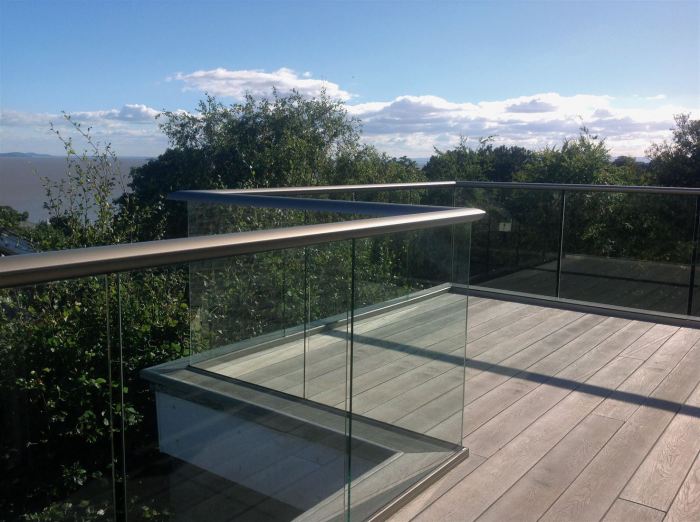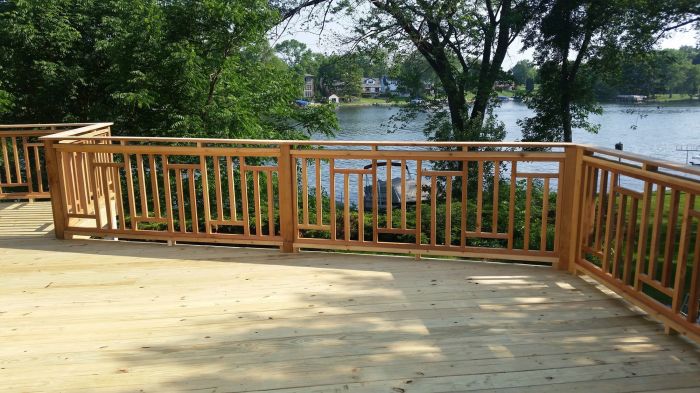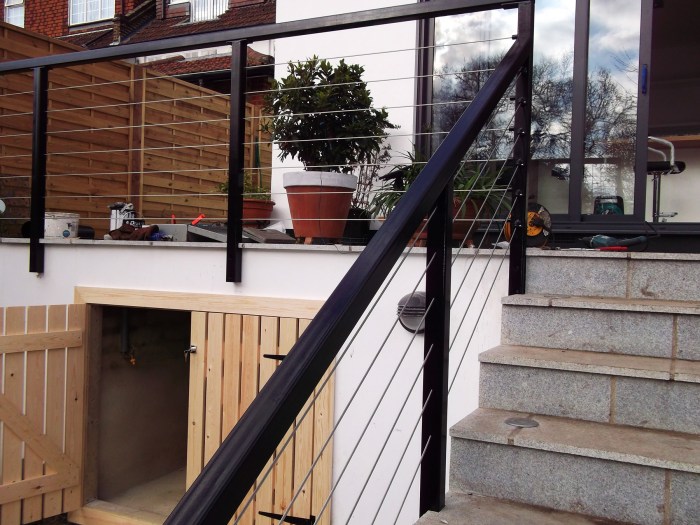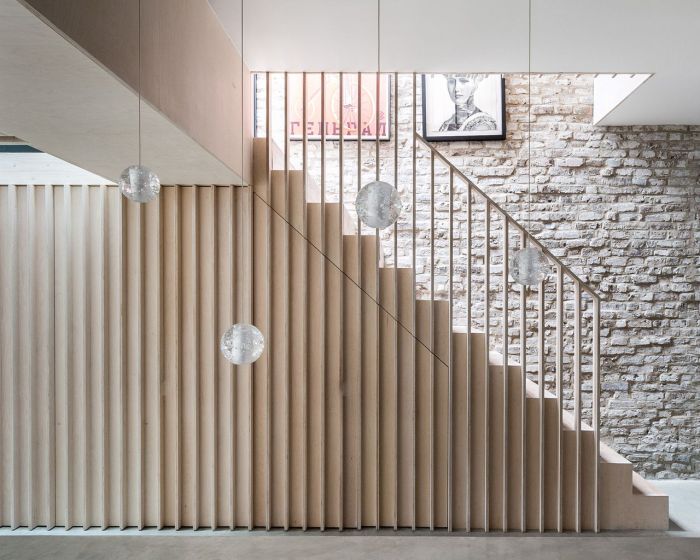Prepare to be captivated by balustrade ideas, an architectural masterpiece that transcends time and style. From classic designs to modern marvels, balustrades add an enchanting touch to any space, offering both functionality and aesthetic appeal.
Balustrades serve as a symphony of design elements, balancing safety with style. Their rich history and evolving forms have left an indelible mark on architectural landscapes, inspiring countless creations that continue to grace our world today.
Balustrade Design Ideas

Balustrades are not just safety features; they are architectural elements that can enhance the aesthetics of any building. From classic to modern, there are numerous balustrade design ideas to choose from, catering to diverse architectural styles and preferences.
The choice of material for balustrades is equally important. Wood, metal, glass, and stone are commonly used materials, each offering unique advantages. Wooden balustrades exude warmth and elegance, while metal balustrades provide durability and a contemporary look. Glass balustrades offer transparency and a sleek aesthetic, and stone balustrades add a touch of grandeur and timeless beauty.
Unique and Innovative Balustrade Designs
- Asymmetrical Balustrades:Break away from symmetry with balustrades that feature varying heights, shapes, or materials on different sides.
- Curved Balustrades:Introduce a touch of elegance with curved balustrades that follow the contours of a staircase or balcony.
- Illuminated Balustrades:Add a touch of magic to your balustrades by incorporating LED lights that illuminate the railings at night.
- Mixed Material Balustrades:Combine different materials to create visually striking balustrades, such as glass panels with metal accents or wooden spindles with stone posts.
- Intricate Carvings:Adorn balustrades with intricate carvings that add depth and character to the design.
Balustrade Function and Purpose

Balustrades, composed of an arrangement of vertical balusters topped by a horizontal rail, serve both functional and decorative purposes in architecture.
Functionally, balustrades provide safety by preventing falls from elevated surfaces such as balconies, staircases, and terraces. Building codes often specify minimum height and spacing requirements for balustrades to ensure they effectively prevent accidents.
Safety Considerations and Building Codes
- Balustrades should be at least 36 inches high to prevent falls.
- The spacing between balusters should not exceed 4 inches to prevent children from getting their heads or bodies stuck.
- Balustrades should be securely anchored to the structure to prevent them from being knocked over.
Historical Evolution and Architectural Significance
Balustrades have a long and rich history, dating back to ancient Greece and Rome. Originally used for structural support, they gradually evolved into decorative elements, adding elegance and grandeur to buildings.
In the Renaissance period, balustrades became a prominent feature of classical architecture, often adorned with intricate carvings and moldings. During the Baroque and Rococo periods, balustrades became more elaborate, with curved and twisted balusters and ornate railings.
Today, balustrades continue to be an important architectural element, adding both safety and aesthetic appeal to buildings of all styles.
Balustrade Types and Styles: Balustrade Ideas
Balustrades come in a wide variety of designs, each with its unique characteristics. They can be categorized based on their design elements, such as spindles, balusters, and handrails.
Spindles are the vertical supports that form the main body of the balustrade. They can be made from a variety of materials, including wood, metal, and stone. Balusters are the decorative elements that are placed between the spindles. They can be carved with intricate designs or left plain.
Handrails are the horizontal supports that run along the top of the balustrade. They provide support for people who are using the stairs or balcony.
Balustrade Styles
There are many different styles of balustrades, each with its own unique look and feel. Some of the most popular styles include:
- Victorian balustrades are characterized by their ornate spindles and balusters. They are often made from cast iron or wrought iron.
- Georgian balustrades are more restrained in their design. They typically have simple spindles and balusters made from wood or stone.
- Art Deco balustrades are characterized by their geometric designs. They are often made from metal or glass.
When choosing a balustrade style for a specific architectural project, it is important to consider the overall design of the building. The balustrade should complement the style of the building and enhance its overall appearance.
Balustrade Materials and Finishes

Choosing the right material and finish for your balustrade is essential for both aesthetic and practical reasons. Here’s a breakdown of the advantages and disadvantages of different materials, as well as the various finishes available:
Materials
- Wood:Classic and versatile, wood balustrades offer warmth and character. They can be painted or stained to match any decor, but require regular maintenance to protect against rot and insects.
- Metal:Durable and low-maintenance, metal balustrades are available in various finishes, including powder coating and anodizing. They’re ideal for both indoor and outdoor use, but can be more expensive than other materials.
- Glass:Modern and elegant, glass balustrades provide unobstructed views and allow natural light to flow through. They’re easy to clean and require minimal maintenance, but can be more fragile than other materials.
- Stone:Luxurious and timeless, stone balustrades exude sophistication and durability. They’re resistant to wear and tear, but can be heavy and expensive to install.
Finishes
- Paint:A classic finish that allows for customization and touch-ups. However, paint can chip or peel over time, requiring regular maintenance.
- Stain:Enhances the natural grain of wood, providing a rich and warm look. Stains offer some protection against moisture, but require reapplication over time.
- Powder Coating:A durable finish that creates a smooth, corrosion-resistant surface. It’s available in a wide range of colors and textures.
- Anodizing:An electrochemical process that creates a protective oxide layer on metal surfaces, enhancing durability and resistance to corrosion.
Selection Guide
Consider these factors when selecting the material and finish for your balustrade:
- Environmental Conditions:Wood and metal are susceptible to moisture and temperature fluctuations, while glass and stone are more durable in harsh environments.
- Maintenance Requirements:Metal and glass require minimal maintenance, while wood and stone may require regular cleaning, painting, or sealing.
- Aesthetic Preferences:Choose a material and finish that complements the style of your home and outdoor space.
Balustrade Installation and Maintenance
Installing and maintaining balustrades requires careful attention to ensure safety and longevity. Here’s a comprehensive guide to the process.
Balustrade Installation
The installation process varies depending on the surface and material. Here are general steps for common surfaces:
- Concrete:Drill holes into the concrete, insert anchor bolts, and secure the base plates.
- Wood:Screw or bolt the base plates directly onto the wooden surface.
- Metal:Weld or bolt the base plates to the metal surface.
Balustrade Maintenance
Regular maintenance is crucial for balustrades. Here are material-specific requirements:
- Wood:Seal or paint to protect from moisture and UV rays.
- Metal:Inspect for rust and apply protective coatings as needed.
- Glass:Clean regularly with non-abrasive cleaners to prevent scratches.
- Stone:Seal to prevent staining and erosion.
Troubleshooting and Repair
Common issues include loose balusters, broken rails, and rust. Here are tips for troubleshooting:
- Loose balusters:Tighten screws or replace damaged balusters.
- Broken rails:Replace the damaged rail with a new one of the same size and shape.
- Rust:Remove rust with a wire brush and apply a protective coating.
Balustrade Trends and Innovations

Balustrades are constantly evolving to meet the demands of modern architecture and design. Emerging trends include the use of new materials, innovative designs, and sustainable features.
One of the most significant trends is the use of glass in balustrades. Glass provides a sleek and modern look, and it can be used to create both transparent and opaque barriers. Glass balustrades are also very strong and durable, making them ideal for use in high-traffic areas.
Another trend is the use of metal in balustrades. Metal balustrades can be made from a variety of materials, including stainless steel, aluminum, and iron. Metal balustrades are strong and durable, and they can be powder-coated or painted to match any décor.
Innovative balustrade designs are also pushing the boundaries of architectural expression. Some of the most popular innovative balustrade designs include:
- Curved balustrades: Curved balustrades add a touch of elegance to any space. They can be used to create both interior and exterior barriers.
- LED-lit balustrades: LED-lit balustrades add a touch of drama to any space. They can be used to create both interior and exterior barriers, and they can be programmed to change color to match any mood.
- Green balustrades: Green balustrades are made from sustainable materials, such as bamboo or recycled plastic. They are a great way to add a touch of eco-friendliness to any space.
In addition to the trends mentioned above, there is also a growing demand for balustrades that are sustainable and environmentally friendly. Sustainable balustrades are made from recycled materials, and they can be designed to minimize their environmental impact.
Balustrade Case Studies
Balustrades have been used in architecture for centuries, and they continue to be a popular choice for both interior and exterior applications. From grand staircases to balconies and terraces, balustrades can add a touch of elegance and sophistication to any space.
There are many different types of balustrades available, each with its own unique design and purpose. In this section, we will showcase some successful balustrade projects from around the world, providing detailed descriptions of the design, materials, and construction methods used.
Contemporary Balustrade Designs
- The new headquarters of Apple in Cupertino, California, features a stunning glass staircase with a custom-designed balustrade made of stainless steel and glass.
- The Burj Khalifa in Dubai, the tallest building in the world, has a series of balconies with glass balustrades that offer breathtaking views of the city.
- The Sydney Opera House in Australia has a unique balustrade made of precast concrete that is both functional and visually appealing.
Balustrade Design Software
Balustrade design software provides architects and designers with tools to create and visualize balustrades for various applications. These software programs offer a range of features and capabilities, making it crucial to select the right software for specific balustrade design needs.
Available Software Tools
Several software tools are available for balustrade design, each with its strengths and weaknesses. Popular options include:
- AutoCAD
- Revit
- SketchUp
- 3ds Max
- Rhino
Features and Capabilities
Balustrade design software typically offers features such as:
- Parametric modeling for quick and easy design changes
- Libraries of pre-designed balustrade components
- Rendering and visualization tools for realistic previews
- Integration with other design software
- Material and finish options for customization
Selecting the Right Software, Balustrade ideas
When selecting balustrade design software, consider the following factors:
- Complexity of balustrade designs
- Required level of customization
- Compatibility with existing design workflow
- User interface and ease of use
- Availability of technical support
Balustrade Manufacturers and Suppliers

Selecting reputable balustrade manufacturers and suppliers is crucial for ensuring the quality and longevity of your project. Here’s a guide to help you navigate the market and make an informed choice.
When choosing a balustrade supplier, consider factors such as their reputation, experience, product quality, and customer service. Look for companies that have a proven track record of delivering high-quality balustrades and providing excellent customer support.
Directory of Reputable Manufacturers and Suppliers
- Company A:Renowned for their innovative designs and commitment to quality.
- Company B:Specializes in custom balustrades, offering a wide range of materials and styles.
- Company C:Known for their affordable pricing and extensive product catalog.
Tips for Getting Quotes and Comparing Prices
To ensure you’re getting the best deal, it’s essential to compare quotes from multiple suppliers. Provide clear specifications for your project, including the type of balustrade, materials, dimensions, and any additional features you require.
- Request detailed quotes:Ask for a breakdown of the costs, including materials, labor, installation, and any applicable taxes.
- Compare apples to apples:Ensure that the quotes you receive are for similar products and services to make a fair comparison.
- Negotiate and finalize:Once you’ve compared prices, negotiate with the supplier to secure the best possible deal.
Concluding Remarks

Balustrades, a testament to architectural ingenuity, continue to inspire and evolve, offering endless possibilities for design expression. Whether you seek timeless elegance or cutting-edge innovation, balustrades stand as a testament to the enduring power of architectural artistry.
FAQ Guide
What materials are commonly used for balustrades?
Wood, metal, glass, and stone are popular materials for balustrades, each offering unique advantages and aesthetic qualities.
What factors should be considered when choosing a balustrade style?
Architectural style, safety requirements, and personal preferences are key factors to consider when selecting a balustrade style.
How do I maintain my balustrade?
Regular cleaning, periodic inspections, and proper sealing or painting can help preserve the beauty and longevity of your balustrade.


